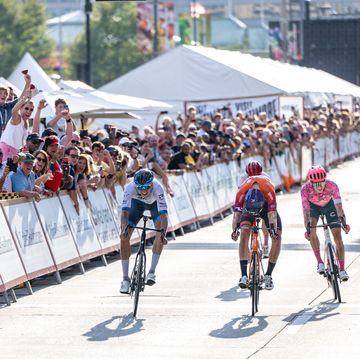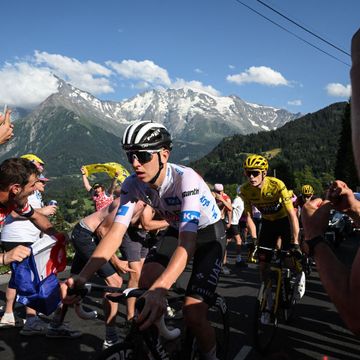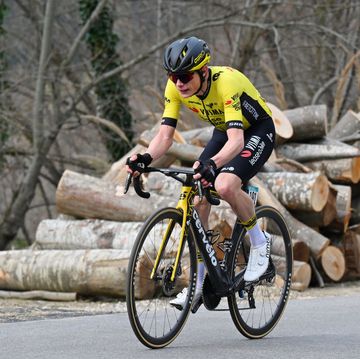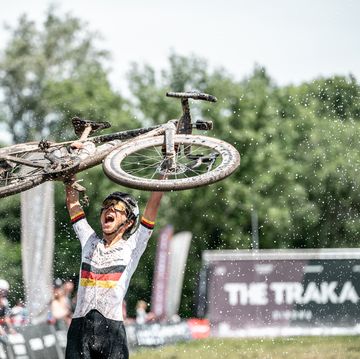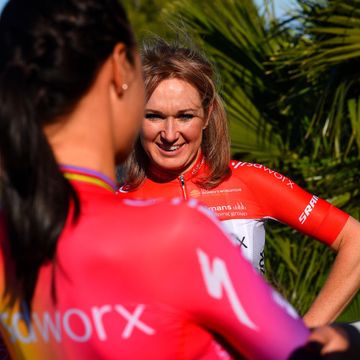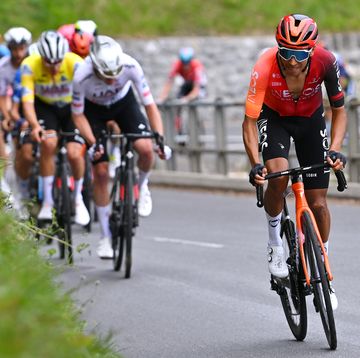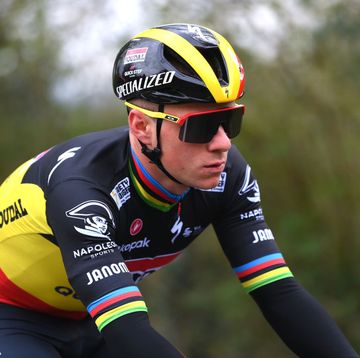This article first appeared in the July 2006 issue of Bicycling magazine.
Francisco Orellano wakes before sunrise. His mornings, sometimes for weeks on end, are nearly always the same. He carries his bike from his apartment to the street. Then he pedals into the dawn. He passes among other riders, who sit upright and silent, moving almost nothing but their legs, which revolve not in spinning cadences but in slow-motion circles. The riders roll forward, determined, toward some unseen destination.
Francisco looks elegant on his bike. His grey hair and moustache are neat; his striped, button-down shirt is pressed. He is proud of his appearance.
He travels the wide boulevards that lead to the shipping terminals at Long Beach, California. He passes unopened supermarkets, unilluminated car lots. Occasionally he pedals through the glow from an all-night filling station. Sometimes, as he rides, he thinks about El Salvador, where he walked to his jobs. But mostly, as he rides, he wonders whether he’ll work today.
Francisco rides to Harbor Park, a green patch amidst the factories and warehouses that cover most of the area. The park is popular with bird-watchers—there’s a marshy lake there—and workers on lunch hour from a nearby hospital. Francisco pedals up to a small trailer and locks his bike to a tree; a dozen other bikes are also chained up. The owners of those bikes, all men, all speaking Spanish, give their names to an attendant, are handed a ticket and wait to be called for work.
Contractors and home owners, who need people to sweep away brush or paint houses or perform other labors, arrive in pickup trucks. Ticket numbers are pulled from a hat, and the bike owners trundle into the trucks, lucky to have been selected for a day that pays $8 an hour, cash. Not every man works every day. Francisco waits calmly. He chats with a few friends. With his dignified appearance, he wouldn’t be out of place if the park had chess tables and he were a retiree spending his golden years at leisure. Instead, he wonders: Will I be chosen? Is today one of those days that adds up to something?
Or will I vanish?
On this June morning, the temperature rises into the 90s by 10. Francisco begins to consider his options. If he doesn’t get work here, he can pedal to a few other sites, a Home Depot or one of several street corners where day laborers for hire congregate. If that fails, he’ll ride home, only to reappear the next day.
RELATED: Philadelphia First Lady Lisa Nutter Gets $h!t Done for Cyclists
Francisco reads the Bible every night, because it costs nothing. “I try to earn $200 every week,” he explains, which barely covers food and rent while leaving him a tiny extra amount he can send back to El Salvador, where his wife and children are—though he quickly adds that his kids are no longer kids.
“They’re grown,” he says, and reaches into his wallet. I think he’s going to show me a family picture, but he pulls out his green card. I’m surprised to learn that he’s 68 years old; he looks younger. He tells me that he arrived from his war-torn Central American homeland 18 years ago, and received political-refugee status in 1989.
Since then, Francisco tells me, he’s cleared hundreds of backyards, seen the inside of countless remodeled kitchens. He’s read through the New Testament a dozen times and pedaled tens of thousands of miles on his bike. He’s wired thousands of dollars back to his family.
“I haven’t seen them in nearly twenty years,” Francisco says. “I miss them so much.” There’s an admonition on his green card, written in letters larger than his birth date, or name, or anything else: “NOT VALID FOR RE-ENTRY.”
Francisco can’t leave. The family he misses, the family he loves, needs the money he can provide only from this country. Thanks to his bike.
RELATED: The Simplest, Cheapest, Most Versatile Shifter Ever
The men who pedal the streets at daybreak with Francisco are invisible in so many ways. Some are here without permission and must hide from the official world. They are not noticed by the cars and buses that roar past, sometimes to tragic effect. They’re not even seen by those of us who claim to love cycling. We’ll pick out a sleek Italian racing bike from across an intersection, but a dozen day laborers on Huffys dissolve into the streets.
I live near downtown Los Angeles. South and east of me are the city’s most densely populated neighborhoods—not Hollywood and Santa Monica and Beverly Hills, which all of America has heard of—but Boyle Heights and Pico Rivera, the only places in California where the number of people per square mile approaches that found in New York, Chicago or Mexico City. The millions of Spanish speakers who live in these neighborhoods provide the region’s muscle and backbone. The bicycle is the blood of this invisible body of labor, as it is all across the United States in a diverse swath of humanity. In southern and central Indiana, the Invisible Riders are largely from, or descended from, Appalachians. New England seems to spawn its own, generations-old breed of independent knockabouts. Hard-luck families of all racial backgrounds wash down from the northern U.S. into the warm southern states, where the dream is that life will somehow be easier without winter. You and I have seen the bikes everywhere—cheap, department-store rigs chained to fences and signposts outside car washes, lumberyards, budget chain restaurants. But we’ve never seen the riders, not really.
“There are more of them than us,” says Aaron Salinger, a public school teacher and bicycle-only commuter who also volunteers as a mechanic for local riders in his Los Angeles neighborhood. The “us” Salinger is talking about is recreational riders, dedicated fitness cyclists, people who commute on two wheels by choice—the readers of this magazine. For several weeks in June, Salinger and I rode among the unseen. The veil was hard to lift. Many riders were afraid to talk to us; some thought we were immigration officers and pedaled quickly away. Salinger’s fluent Spanish helped, and so did our bikes. He was on a lovingly rebuilt vintage Schwinn tourer and I had a titanium racer, which made me feel ludicrous but at least provided a conversation starter. Though almost nobody we met rode recreationally, nearly everyone got some level of pleasure from riding and from bikes. That was something we could share.
Neighborhood after neighborhood revealed surprise after surprise. The Invisible Riders, for instance, log far more hours than most “serious” cyclists. They do so on equipment most of us wouldn’t touch and under the most adverse conditions: at the height of rush hour on the busiest thoroughfares. Workers without documentation have no vacation or sick days, so they keep a grueling schedule. One rider told me that last winter, when Los Angeles received a record rainfall, he didn’t have a single day off.
Riders like me want to believe we’re doing our part for the environment. We want to believe that having the best equipment is an expression of commitment. But I don’t know a single rider who commutes more than the people I met for this story, who do it purely out of necessity, and who do so on bikes that, while fashioned to look like high-end mountain bikes, are stripped of so many essential engineering details that we’d consider them unreliable, unsafe, and certainly unenjoyable.
For the Invisible Riders, two-wheeled transit has nothing to do with style or making a political statement. The Invisible Riders are overtly saying nothing. But their actions? Nothing could be more political, or politically charged, than the way they live.
RELATED: The Worst City for Cyclists
From overhead, the intersection of Vermont Avenue and Wilshire Boulevard could be seen as the center of a giant cross. Each street is an axis of tarmac, dividing quadrants of multicolored mortar made up by block after block of low-slung houses and apartments.
Vermont runs north to south. The avenue’s upper boundary folds into Griffith Park, the nation’s largest big-city recreation area. Heading south, it stretches across every demographic boundary, making a ruler-straight 30-mile run. It passes directly by Harbor Park, where Francisco Orellano looks for work, before changing names and petering out in the peninsular enclave of Palos Verdes. Wilshire Boulevard runs east-west, starting at the Pacific and making an arrow-point through Beverly Hills before ending under the Harbor Freeway, near downtown Los Angeles.
Local recreational riders are intimately familiar with three of the cross’s four terminal points. The smoothly paved loops around Griffith Park and Palos Verdes, and the coastline bike path that begins where Wilshire ends, are well stocked with Treks, Litespeeds, Serottas and the other high-end toys of our sport.
You will rarely see such a fine bike at the center point, at this intersection. That doesn’t mean fine cyclists are absent.
This is a busy spot. There’s a construction site, a gleaming subway station, and bus after bus chugging by, each with its front bike rack nearly filled. At lunchtime on a Wednesday afternoon, riders passed through continually. Though Salinger and I hesitated to guess the ethnicity—let alone the immigration status—of the riders rushing by, we were able to peg the bikes being ridden. They were mostly Magnas and Micargis, popular department-store models in faux off-road style. A couple of messengers on fixed-gear rigs blew by, and one rider on a battered yellow Schwinn. But there didn’t seem to be anybody riding for fun, or the kind of stylish, derring-do bike commuter whose portrait is usually painted in this magazine. Not a single Breezer, Electra, Kona, Specialized, or Bianchi commuter.
It wasn’t easy to get people to stop and talk. A heavyset man on a frame branded simply “Alloy” pedaled around us, saying, “I’m late.”
“At those kinds of jobs,” Salinger pointed out, “there are no second chances.”
RELATED: This is How Many Americans Ride a Bike
One place these riders congregate is MacArthur Park, a city recreational facility a few blocks away. A rider resting on the grass there is somebody who hasn’t found work yet that day, who might be waiting for a second shift to start, or who just won’t go home because the distance, weighed against even the slim chance of getting hired for something, favors staying put. We rode to the park’s southwest boundary, picking through a streetside marketplace of fake green card and driver’s license merchants, then circled the soccer fields and basketball courts on an asphalt outer ring. Dozens of bikes leaned against trees or lay on the scruffy turf. Some men chatted with each other; others simply rested.
“I don’t want to give my name,” said a man on a Schwinn Sidewinder. His bike, which retails for $130 at Wal-Mart, had a basket mounted to the front. The basket was filled with empty plastic bottles. “When I don’t find work, I try to make a little money by turning in empties,” he said. At five bottles for a full basket, and a nickel per bottle, it would take more than 500 round-trips to pay for the Schwinn.
He told us he pedals more than three hours per day, but limited to a miniscule area. No trips to the beach or the foothills. He’d never been farther north than the park we were standing in, or much more than 3 miles in any direction. When I asked why, he got nervous, and the answer was suddenly obvious to me. This is his territory. He couldn’t afford to be caught out, to be jailed or sent back across the border.
A few benches down, Hugo Moreno laid his bike on the ground and took a seat. A muscular 27-year-old with a faint moustache and an easy smile, he’d worked since 6 a.m. and wanted to rest before his ride home to Pico Rivera, a community at the heart of immigrant Los Angeles. I asked Moreno if his bike was a good substitute for a car. He looked at me with incredulity. “It’s more like a horse,” he said.
Moreno’s 9-mile commute is tough on gear. He’s gone through two bikes a year, spending more than $500 on equipment since his arrival in the U.S. four years ago.
The question I immediately asked—and almost as immediately felt embarrassed for asking—was why Moreno didn’t simply buy a single $500 bike that would last and be easier to ride. Moreno stared across a world at me. “That much money?” he said. “I can’t put that together at one time.”
When his last bike failed, Moreno explained, it took three months to save up for a new one, and it was a slippery, nearly impassable slope. “No bike, and I have to take the bus,” he said, “and that costs money.”
RELATED: This Family Gave Up Driving for 30 Days
Moreno said he had a very cautious riding style—not going too fast, not weaving in and out of cars, sometimes pedaling on the sidewalk. He says it’s not because he’s afraid of being injured while riding, but because whenever he lost a bike he could never be sure he’d be able to get another. The couple of bucks a day spent on mass transit, the $75 or $100 that must be saved for a new purchase— that’s money his family back in Mexico will never get.
“I can’t afford to lose that,” he said.
Dreaming of a world of smiling cyclists, of more bike paths, with less traffic congestion and coexisting modes of transportation, is easy for riders like us. But on the streets, on a cheap—yet priceless—bike, there’s little opportunity for idealism. Pragmatism and attention keep you alive. Safety sometimes has little to do with helmets or skillful riding techniques.
“My bike is safer,” Francisco Orellano says. What he means is this: Working day-to-day, he’s usually paid in cash. When he took the bus, he faced a long and often late-night walk from the stop to his home, with a pocketful of money. One time, “I was robbed,” he says. “That won’t happen to me on a bike. My bike is safer.”
This doesn’t mean the usual dangers of the street don’t exist. They’re worse. Only one of the riders I met wore a helmet, and he did so, he said, because he was afraid of being stopped by police; even a minor encounter with the law can lead to deportation. (I felt absolutely conflicted, because he was under the healthful misconception that helmets are mandatory for adults.)
Many riders pedal up the left lanes, against traffic. The reason, according to a 2004 study by the National Highway Traffic and Safety Administration and the Federal Highway Administration, is “significant cultural differences that affect how Hispanics behave as pedestrians and cyclists in the United States.” In much of Central America, riding against traffic is the norm, and therefore safe. The report notes other dangers. For instance, signs advising “yield” rely on a word that doesn’t translate well, and whose logistical gist can be nonexistent on third-world roads.
Even the most familiar features of our roads become obstacles.
“If you’ve never seen a crosswalk,” says Christine Brittle, a research analyst with The Media Network, a group that helped conduct the federal studies, “how do you know what to do when you get to one?”
On the street, these factors play out in tragic ways. Los Angeles, according to federal and state statistics, is the most dangerous city for cyclists in the country, routinely at or near the top of the list for bicycle-car accidents. In 1999, the last year for which unified statistics were available, 3,878 L.A. riders were injured in collisions with automobiles, with more than 1,000 of those injuries requiring hospitalization.
RELATED: Do Helmet Laws Unfairly Target Minorities?
Most of the riders I met viewed their commute as a battle, but exhibited none of the smug, anti-automotive posturing many committed middle-class bike commuters wear as a badge of honor. Guillermo Diaz, who works at a restaurant near MacArthur Park, was standing near the entrance of a shopping center, waiting for a friend. He lives in a house with seven others, all of whom ride bikes, all on the sidewalk. I thought of cycling advocates who engage in pitched ideological battles over whether it’s safer to mix bikes and traffic or to separate them. There’s no doubt that a rider with the skills and equipment needed to navigate alongside cars is probably best balanced between efficiency and safety, but I couldn’t argue with Diaz that getting off the sidewalk is simply “too dangerous.”
The major arteries from South Central into downtown are huge—sometimes eight lanes wide. Because they pass through some of L.A.’s oldest and poorest neighborhoods, road surfaces are generally crummy. The bridges that cross from East Los Angeles into downtown, spanning the concrete-covered flood-control channels of the Los Angeles River, are narrow and long. Traffic quickly accelerates to freeway velocity—a nearly impossible situation for any rider, let alone one on a bike with heavy wheels, clunky suspensionk, and less-than-powerful brakes. On the sidewalk, in comparison, the guarantee of safety is nearly absolute.
What would it take for Diaz to use the streets?
He answered instantly, without a hint of irony: “Owning a car.”
The store Diaz stood in front of was La Curacao, a department store that outfits most of the Invisible Riders of Los Angeles.
The Olympic Boulevard flagship store, one of six in the city, is just a few blocks from MacArthur Park. When you step inside you’re met with a wall of music and light; videos play on a prominently displayed plasma television, and aisles of consumer goods—from portable massagers to low-priced computers with Spanish AOL installed—are constantly demo’d by attentive staff.
Customers buy goods here that they can’t get anywhere else, because La Curacao offers easier credit than competing retailers. (The average monthly income of a La Curacao cardholder is $1,500, and a social security number isn’t required to get credit.) They also shop here because products that are either prohibitively expensive or not available in their home countries can be shipped by the store’s export desk. La Curacao also wires money and sells plane tickets.
The store’s slogan is “un poco de su pais,” or “a little of your country,” and with live mariachis and no English-language signage, the store has a distinctively Latino feel. But a complementary catchphrase could be “a whole lot of America.” The washing machines, cordless phones, watches, perfumes, and Oakley sunglasses are an aspirational on-ramp to the life its customers are struggling to reach. Bicycles are the vehicles needed for the journey. During the holidays, the store stocks so many two-wheeled offerings that it sets them up outside, with more than 100 gleaming rigs stretching across a brick patio decorated with Aztec-inspired friezes. The bikes are like the offerings at Anglo outlets, but with a few custom touches. Curacao’s house brand is the Maya Tour, the name a crafty amalgamation of back-home pride and the argot of new-country leisure. Huffy, a trusted label among the Invisible Riders, is also stocked.
Most of us know these bikes aren’t a good choice for daily, hard riding, such as commuting. I wondered what the lineup might look like at the bike shops frequented by these commuters—if they could even afford to patronize real bike shops.
As it turns out, the Los Angeles yellow pages lists many more bike shops in the zip codes that cover South Central and East L.A. than in the wealthier parts of town. But the definition of bike shop is different. Some double as florists, gift shops, or even auto-repair outlets; some also sell groceries and hardware. At the Alameda Swap Meet—a sprawling, indoor/outdoor marketplace that resembles the traditional town-square mercados found throughout Latin America— Tony and Maria Mata sell bikes and baby carriages in a stall bordered on one side by a tattoo parlor, and on the other by a butcher shop. The primary brand they offer is Micargi. An SM80 with 24-inch wheels and full suspension costs $100, assembled. Another brand is the somehow Lance-inspired Firmstrong. The couple have come up with their own way to compete with Curacao’s easy credit terms: They sell bikes mostly on layaway.
RELATED: Where to Buy a Used Bike That Isn't Stolen
“Usually,” says Maria, “it takes three or four months for somebody to pay.”
Independent shops find it hard to compete with high-volume department stores on price, even though they sell the same bikes. (The shops you and I visit have the same problem, but the issue is mitigated because they sell high-profit offerings you’ll never find at a big box store. In the eight bike shops I visited along the Wilshire/Vermont corridor, only one stocked a bike that cost more than $140.)
Inner tubes, at $2 each, make up the bulk of Tony and Maria’s sales. Yet even that purchase can spell disaster for their customers. Jesus Galvez, who owns a shop on South Central Avenue, says the typical customer is desperate: “Somebody comes in and says, ‘I have three dollars—can you please make it work!’”
Galvez gestures at the piles of bike parts that crowd his shop so heavily you can barely move through it—the gran surtido de partes, or “grand assortment of spares,” his business card advertises. “You find ways to keep people rolling,” he says.
There are cheap ways to get good bikes in Los Angeles. At the Harbor Park labor center, I was told about a mysterious mobile bike dealer named Carlos, who sells older—and nicer—steel road bikes. Their origin is indeterminate. A 1980s Trek or Schwinn can cost as little as $20, and though it would ultimately be a faster, more comfortable and durable bike for commuting, it isn’t seen as desirable by the Harbor Park buyers.
RELATED: Advocate Cycles Makes Buying a Bike a Charitable Act
“A mountain bike is better,” said one of the riders I interviewed. “Mas resistente.”
Riders who end up on these stolen bikes simply can’t afford even an $80 Firmstrong— very recent immigrants, or those who’ve lost a more costly bike and can’t negotiate the convoluted economics of continuing to work while saving for a new one.
But having even an unwanted better bicycle can have unintentionally transformative effects. Echo Park is a compact recreational area tucked between the Hollywood Freeway and Sunset Boulevard, known for a summertime salsa festival and for pedal boats families can navigate around a tiny lake. While there, I noticed an Invisible Rider on a Trek with clipless pedals and bar-end shifters. Octavio was hesitant to talk, but he was fascinated by the Seven I was riding (which, again, I felt totally embarrassed to be on). He told me he’d bought the Trek for transportation, but then expressed a passion for his bike that was unusual among the Invisibles.
“This is all the car I’ll ever need,” he said, smiling.
Several times, to Octavio’s increasing anxiety, I asked where he’d gotten the Trek. “I bought it from a friend,” he said. A few moments later, he told me it was a gift.
The bike’s customizations, a Blackburn rack and a Brooks saddle, almost surely signaled that it was once somebody’s prized possession. But Octavio had discovered a genuine enthusiasm for riding. I found myself thinking a strange thought: Maybe he deserves this bike. Even if it is stolen. This notion came to me even though I’d had two bikes stolen from me, less than a mile from this spot.
I can’t think of a harder cycling life. I saw young men lugging heavy bikes to elevated rail stations, wheeling them into trains and keeping one eye on them as they sat, exhausted from a 12-hour day at a downtown factory, anticipating another 5 miles of riding after exiting at the stop nearest their home. I heard a story about a rider in the relatively calm, upscale suburb of Glendale who was hit by a car as he rode to work—after traversing the more-dangerous streets early in his commute. The accident happened in front of a hospital, but because the rider had no insurance, he was taken by ambulance to the county emergency room 10 miles away. The diagnosis was a broken pelvis, but there were complications, and the patient slipped into a coma. He died six weeks later. I was in a shop when a rider came in with a flat-tired Micargi he said he’d pushed for 2 miles. When the shop owner informed him that he needed a new tire, not just a tube, the rider pulled a handful of change from his pocket—not enough for the repair—and offered it, stiffening with pride to mask his humiliation.
But the surprise isn’t that this cycling life is harder. That’s something any of us might have imagined, though we’d have been sketchy on the details. What’s surprising is how committed these riders are to the activity of cycling—even more, it’s hard to admit, than those of us who love the sport.
Last year, the Los Angeles County Bicycle Coalition conducted a survey that used a neat trick to partition the city’s two-wheeled community. Half the questioning was conducted via the Internet or mail; the other half of the respondents were approached on the street. One notable result: 42 percent of the street respondents said they rode five days a week or more. Only a quarter of the remotely queried cyclists rode that much.
And the riders who pedal so much more accomplish it with far fewer resources: 40 percent of the street respondents earn less than $15,000 annually (65 percent earn below $35,000), and 95 percent of them own just a single bike.
RELATED: This is What a City Where Everyone Rides Bikes Looks Like
Nearly half of those surveyed by Internet and mail reported earnings of more than $75,000. The household income of subscribers to this magazine is $112,000, and, on average, four bikes are parked in our garages. If you’re a typical subscriber, you plan to spend at least $2,000 on your next bike, but a passionate 4 percent of you say you’ll spend $6,000 or more.
To say that those figures provoked shock in the world of the Invisibles is an understatement. Bike-shop owner Maria Mata found it hard to believe such machines exist. One-fifth of the respondents to the Los Angeles street survey earn less than $7,000 in a year.
Maybe these riders won’t leave behind the idea of bikes as something to be used, rather than enjoyed, as we have. Maybe, as they and their children struggle up the American ladder as all immigrants have—ascending to car and home ownership, then college education and beyond—they’ll tell nostalgic stories of how two wheels made it all possible. Maybe the Invisible Riders will be the catalyst that transforms our polluted cities, fulfilling the mission that the conventional, more-well-heeled bike community has so far failed at.
So why not now? Why not build bike paths, and safer streets, and secure parking, and inexpensive, practical bikes, and financial incentives for riding, and all the other things we recreational riders dream of—and which riders like Francisco actually need?
The answer is simple, and cruel: Because Francisco, and the other riders like him, are invisible. And the answer is wrong. The question, in fact, is wrong.
RELATED:Help Change the Way We Report Bike Deaths
The real question, the one that must be asked first, says Kastle Lund, executive director of the L.A. Bike Coalition, is, “Why do so many of us fail to see these groups as constituencies that even exist, let alone that we need and are duty-bound to serve?”
Francisco is not invisible. These riders, on these streets, in the peril of traffic and smog, have not somehow made themselves hard to see. If I hadn’t seen them in 15 years of daily riding in Los Angeles—and if you haven’t seen them in your cities—it’s not because they are transparent.
It’s because we are blind.
Aaron Salinger, the bike-riding translator, and I were talking as we sat in MacArthur Park. One of the goals I originally had was to see if these riders could somehow transform into racers, tourists, enthusiasts like us.
Salinger nearly laughed. Kids, he said, have a better understanding of bikes than I do. He told me about what happened when he assigned his second-grade class to draw pictures of people doing things on bikes—“whatever you imagine,” he’d said.
One student drew his father on a superbike, vaulting the border from Mexico. Another drew a comic: Bike riders rob a bank, pedal to evade police, and use the money to open a business.
Evidence of moral weakness? No. Evidence of how powerful the desire to live in the United States, and participate in our prosperity, can be. And of the central role the bicycle plays in that dream.
Ask your friends why they ride. To summit mountains, to swoop along singletrack, to lose weight, to get fit. To see things. To feel free. Francisco Orellano doesn’t ride to be seen. He rides to become free.
When the Wrong Bikes Are Right
It would be easy to compare the 37.5-pound Magna Excitor XP3000, which I bought for $79 at Target, to the high-dollar machines I usually ride and call it junk. Easy—and not only unfair but completely clueless in the context of the Invisible Riders.
About 15 million bikes just like this are sold in the U.S. every year. These mass-market rigs often cost less than $100. They’re ponderously heavy, not as strong as frames that cost just slightly more and are sold in bike shops, and come in extremely limited sizes. Often, they’re poorly assembled by store employees, with components such as brakes, shifting systems, and wheels stripped to the bare minimum in order to afford consumer-pleasing full-suspension systems—which not only barely work but can actually hinder comfort and efficiency.
It would be one thing if I were going to evaluate this bike’s worth as a first bike for a child, or for use by a middle-class member of society interested in fitness and recreation. But in the context of my research, I realized that bikes like the 21-speed Excitor are the choice of thousands and thousands of cyclists, who pick it not because it is the best, but because it’s the best bike they can afford. I wanted to spend a week evaluating the Excitor from that perspective: Can it handle short-haul commutes, day in and day out?
RELATED: How Bike Maintenance Empowers International Students
The last time Bicycling reviewed a mass-market bike, one of the big problems was unsafe assembly. My bike had only a loose headset. (But when I tightened it, the octagonal lock bolt rounded; low-quality fittings make these bikes fragile during repairs.) The brakes and gears were functional; the tires were properly inflated, and the wheels ran true.
I rode home. The suspension was like sinking into a big sofa. The heavy wheels felt slow, and the brakes rapidly lost their effectiveness as I gained speed. The bike was hard to ride—and no fun.
I realized I was trying to ride like myself rather than the way the people I’d spent weeks interviewing did: slowly, sometimes on the sidewalk.
Surprise! Ridden that way, the Excitor turns out to be suited to its purpose. And, over a week of use, it didn’t break or endanger me.
Would a more expensive bike from a bike shop do better? For sure. A $250 city bike from a local bike shop is more efficient, easier to handle (and to carry up and down stairs), and sturdier by far more than the price multiple. But the real question is why companies can’t make a sub-$100 bike that’s closer to the city bike than the Excitor.
Stop larding up mass-market bikes with suspension and bar ends, and you could spec a simpler, stronger, lighter bike with better wheels, brakes, and shifters—an ideal urban work machine at the required price.
RELATED: Saving the World, One Bike Ride at a Time
“You could do that even cheaper,” says one bike-industry executive who works for one of the large department-store-oriented importers (and who asked not to be named). “They’re already built— they’re what people ride in China and Thailand and all over Asia. The problem is that’s not what the stores in the United States want.”
The reason U.S. department stores sell faux mountain bikes, the executive says, is simply because that’s what sells. The bike industry (including the media) and image makers outside of the sport spent years making mountain biking sexy—and thus desirable to the general public. Bikes that look like road bikes haven’t been considered cool, or aspirational, and won’t sell.
In a kind of inverse proof of this, with sales of off-road bikes declining and the rise in popularity of Lance Armstrong, Wal-Mart recently added a $150, one-size road bike to its aisles. We might yet see the Invisible Riders on more sensible machines.
It’s Not Transporation— It’s A Business
Sometimes an Invisible Rider uses a bicycle in a way more traditionally associated with the world’s image of how bikes can help those at the bottom of the economic ladder: not merely to get to a job, but as a job.
I met a cyclist named Jorge Diaz who told me he spends a minimum of five hours a day selling food, drinks, and other items from his bike.
For the past eight years, the stocky, square-jawed immigrant from El Salvador has ridden loops around Lafayette Park on an undersized BMX bike attached to a cart. In the cart the day I interviewed him: drinks in a cooler, cigarettes, candies and plastic bags of homemade, pinwheel-shaped crunchies. (They’re kind of like onion rings; you eat them drenched in salsa.)
The locals who play soccer and basketball are his customers. “Some of them, I see every day,” Diaz says.
It’s a hard living, but a good one. When Diaz arrived in the U.S. in 1989, he took a typical job—working 12-hour shifts in a restaurant for about $30 a day. After taking care of rent and food, and sending money back home, he didn’t “even have a quarter to buy a soda with,” Diaz says.
His bike ride to his job passed the park, and he remembered how back in El Salvador his brother earned extra cash by selling cold water to soccer players. Using money earmarked for rent, Diaz bought $20 worth of soda.
But he made a mistake, he says, buying “quality soda— Coke and Squirt, and asking 75 cents a bottle.” It took a week for him to sell six. When that case was gone, he bought generic beverages for which he could charge less, and quickly sold out. “Soon people were asking if I had snacks,” he says.
Diaz’s human-powered convenience store weighs about 100 pounds and earns about $250 on a good day. The money has enabled him to buy a small coffee and apple plantation on about two acres in El Salvador, and to support his parents, who still live there. But most of his success is focused on his children, he says. On the afternoon we met, Diaz’s five-year-old daughter was part of the BMX bike’s cargo. “She wants to go to dancing school,” Diaz says. “I want to give her the chance to triumph.”








